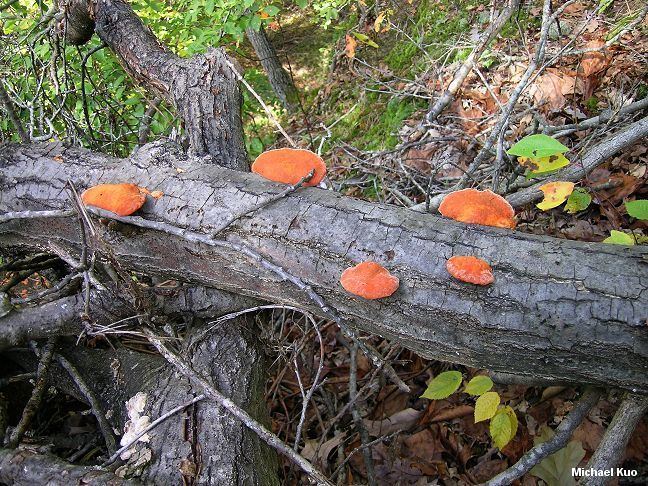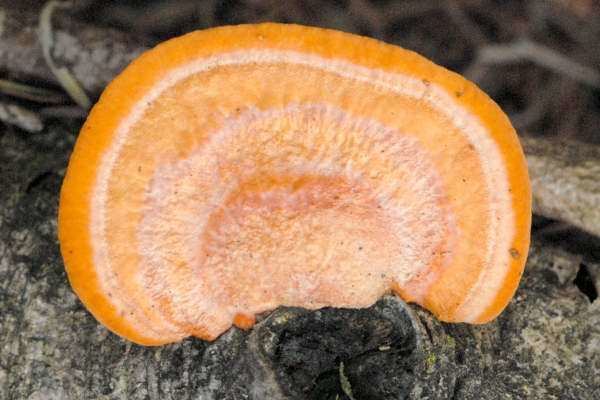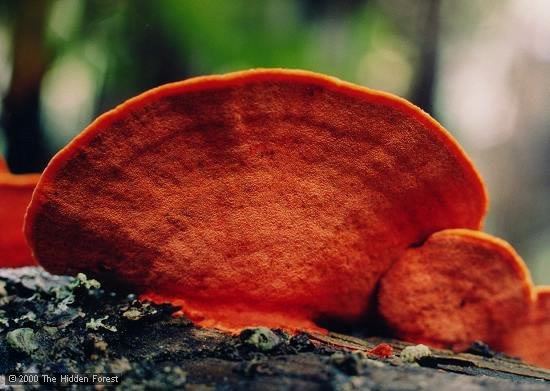Kingdom Fungi | Division Basidiomycota Rank Genus | |
 | ||
Lower classifications Pycnoporus cinnabarinus, Pycnoporus sanguineus | ||
Pycnoporus cinnabarinus a red polypore bracket fungi
Pycnoporus is a genus of fungi in the Polyporaceae family. This genus is distinguished from most other polypores because of its brilliant red-orange color. Modern mycology recognizes five distinct species of Pycnoporus: the type P. cinnabarinus, P. coccineus, P. palibini, P. puniceus, and P. sanguineus. These species are divided somewhat by morphology, biogeography, and DNA sequence.
Contents
- Pycnoporus cinnabarinus a red polypore bracket fungi
- Pycnoporus sanguineus fungi kingdom
- Biogeography
- Description
- Identification
- Industry
- References

Pycnoporus sanguineus fungi kingdom
Biogeography
Pycnoporus cinnabarinus occurs in cooler, temperate regions within Europe and North America. Pycnoporus sanguineus occurs in warmer, tropical regions within South America, North America, and Asia. Pycnoporus coccineus occurs in temperate areas of Australia and New Zealand. Pycnoporus puniceus is a rare species found in Southeastern Asia and Malaysia. Pycnoporus is used in industry as a source of powerful lignolytic enzymes that degrade paper and plastics. This fungi is studied in the production of laccase for use in biotechnology.
Description

Fruiting bodies are typically sessile, corky, slightly tomentose to glaborose. on fallen hardwood logs, but can be on coniferous trees as well. These fungi live in diverse habitats, but are typically located near a source of water. Pileus length x width x height (thickness) can range from 1-9 cm (l) x 1-7 cm (w) x 0.2-2 cm (h). Colors range on the scale of paprika red to flame orange but almost always are vibrant. Spores are white, oblong, somewhat pointed, 2-3 x 4-6 um. KOH reactions yield a dark brown to black color for most specimens but can bleach out (turn white) the pileus of a few specimens over longer time periods. Specimens typically retain their strong red-orange color for long periods of time, especially when dried and stored properly. Yet some turn dingy brown or gray and fade in color over time.
Identification

In order to identify the species of Pycnoporus a few characteristics must be carefully observed. To distinguish between P. cinnabarinus and P. sanguineus one must note the thickness of the pileus. P. cinnabarinus has a fruiting body ranging from 5 to 15 mm in thickness while P. sanguineus ranges from 1-5 mm thick. Additionally P. sanguineus typically contains darker red pigments that do not easily fade. Several collected specimens of P. cinnabarinus show pale orange pigmentation in areas with direct sunlight. Lastly, P. cinnabarinus contains larger pores per mm (2-4) than P. sanguineus with 4-6 pores per mm.
Industry

Pycnoporus fungi are used heavily for industry because of their ability to produce powerful lignolytic enzymes that break down lignin and tough polysaccharides in wood and paper. The major enzyme that differentiates this fungus from other white rotters is laccase and under the correct conditions Pycnoporus can produce large concentrations of this enzyme. Other uses have been reported in Australia. Aboriginal peoples have used it for curing mouth sores, ulcers, and teething of infants.
